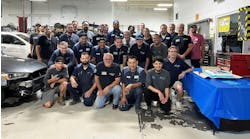Nissan: Finisher and door panel contact causes squeaking
The owners of some 1996-99 Nissan Pathfinders have registered complaints about their SUVs making squeaks, creaks and other odd noises, emanating from various parts of the door finishers when they're driven on pavement or rough roads at speeds over 15 mph. Nissan has traced this problem to contact between the finisher and the door panels and suggests the following repair procedures:Verify that the noise is emanating from the upper part of the front door finisher area by pressing on the upper part of the door finisher. This should eliminate the noise. To repair, follow these procedures:
Remove the following pieces:
- inside door release handle finisher
- door arm rest
- power window and power door lock switches (be sure to disconnect the wire harness connectors)
- screws that secure the door finisher
- clips that secure the door finisher
- door finisher
Put the pieces removed in Step 1 back in place and road test the vehicle.
Verify that the noise is emanating from the rear end of the door finisher area by pressing on the front door finisher. This should eliminate the noise. To repair:
Verify that the noise is emanating from this area by pressing on the upper part of the door finisher. This should eliminate the noise. To repair:
Repeat Step 1 from the previous section.
Apply felt tape (P/N 68239-13E00) to the door finisher as shown in Fig. 2. Apply the tape along the entire length of the area where the door finisher contacts the door panel (about 150 mm).
Put the pieces removed in Step 1 back in place and road test the vehicle.
Chrysler: Fuel System Blockages
A new car owner can certainly find more serious things to complain about than a fuel tank that is slow to fill. Nevertheless, this is a problem that shouldn't be ignored since it could be a part of a more serious defect that might eventually leave a motorist stranded. Chrysler has reported slow-fill conditions on some of its 2001 LHS, Concorde and Intrepid models and discovered that the cause is a lack of venting in the fuel system. The lack of venting can be the result of several different problems: a kinked or plugged vent line, a faulty control valve, a plugged LDP filter or even a restricted filler tube. The only way to determine the true source (or possibly sources) is to disassemble and thoroughly inspect each of these areas. Chrysler has supplied the following diagnosis and repair steps:Begin by disconnecting the battery.
Use the appropriate service manual procedures to lower the fuel tank from the underside of the vehicle. If necessary, drain fuel from the tank in order to make it lighter or safer to handle.
Inspect the vent lines between the fuel tank and the evaporative canister. Check for a possible kink or blockage and correct as necessary.
Locate the LDP filter (see Fig. 3) and determine if it is plugged. (Since this is often a result of aftermarket undercoating or other debris, check with the customer to determine if the vehicle has either been undercoated or driven in severe, especially muddy, conditions.) If the filter is plugged, replace it with P/N 04581236.
Disconnect the hoses from the fuel control valve. Use a hammer and brass drift to remove the fuel control valve lock ring.
Remove the fuel control valve from the fuel tank and locate the mold cavity number (see Fig. 4). If the mold cavity number is four, replace the control valve with P/N 05016387AA. Note: If the valve was stuck closed, the system would be unable to vent, resulting in the slow fill condition. If the valve was stuck open, the vehicle could be "overfilled" which could cause fuel to carry over into the canister.
Check the fuel filler tube recirculation line to determine if it is plugged or restricted with paint from the filler tube supplier's manufacturing process. Begin by removing the filler tube.
Insert a small ball bearing (1/4 in.) at the fuel tank end of the filler tube re-circulation line. If the line isn't blocked, the ball bearing will travel freely through the re-circulation line and into the larger tube. If the line is plugged or restricted, replace the fuel filler tube assembly (P/N 04581319AB).
Reinstall the fuel tank. Replace any fuel that was drained.
Connect the battery and reset the clock to the correct time.
Ford: Airbag Warning
Ford Motor Co. designs its U.S. and Canadian models with dual stage air bag modules that are designed to deploy both stages during all deployments. This means that even if a crash warrants only a first stage deployment, the vehicle electronic system will still deploy the second stage, but in a way that does not increase the energy during the first stage. Unfortunately, like all best laid plans, there are cases in which only the first stage deploys successfully, putting autobody technicians at risk for dangerous second stage discharges that can occur while the vehicle is being repaired. To prevent such accidents, Ford now recommends that all air bags in wrecked vehicles be treated as if they were live if there is any doubt that both stages have deployed. Technicians should make it a practice to regularly inspect the air bags to determine (1) if the bag is not out or (2) if the cover is not open. These are good signs that two-stage deployment was not successful. If you encounter any of these situations, refer to the appropriate service manual or contact the appropriate Ford Motor Co. dealer for disposal instructions. Current Ford/Lincoln/Mercury vehicles with dual stage front driver and passenger airbags are:- 2000 Taurus/Sable
- 2001 Crown Victoria/Grand Marquis
- 2001 Town Car
- 2001 Windstar.
NISSAN: Iron particles in paint jobs
Nissan has issued bulletin BT01-048 NTB01-087 dated Dec. 5, 2001, with recommendations for removing iron particles from paint and how to identify them.Environmental iron particles can be identified in paint as small, rust or orange colored dots with black centers or as small, white or silver dots with a "rainbow hue" around the edge. The surface will also feel rough or gritty.
The following steps have been found effective in most cases for removing environmental iron particles (sometimes called "rail dust") from a vehicle's painted surfaces.
Service procedure caution: In most cases these environmental iron particles can be easily removed, but create more damage the longer they are left untreated-and the harder they are to remove. In rare, more severe cases, spots of paint blistering can occur.
1. Use a magnifying glass to check if iron particles are present.
2. Wash the vehicle with soap and warm water. Completely dry the vehicle.
Note: There are three steps of damage repair possible that should be completed in the order given. Start with step A first. Complete step B if necessary. Proceed to step C only if iron particles are not removed in the preceding steps.
3. Repair the paint damage.
A. For light/medium damage (surface level only). Remove the iron particles using a clay bar, a clay-like surface cleaning material or equivalent.
B. For medium damage (surface level only). Remove the iron particles using a chemical cleaning product such as an industrial fallout remover (i.e. oxalic acid) or equivalent; or a chemical neutralization system
C. For heavy damage (deep into the clear and/or color coat):
This step will require wet sanding and/or repainting. Contact your local paint refinish supplier for recommended procedures.
Caution: Only an experienced paint technician who is familiar with proper refinishing techniques should perform the above repair.
For more information on identifying and diagnosing iron particles and other paint issues, refer to the Nissan/Infiniti paint incident identification manual, P/N 5PII00, or call (800) 247-5321 for a copy of the Nissan/Infiniti Paint Incident Identification manual,refer to the current Nissan warranty flat rate manual, "Environmental Damage," and use the coding that best describes the level of repair performed.



